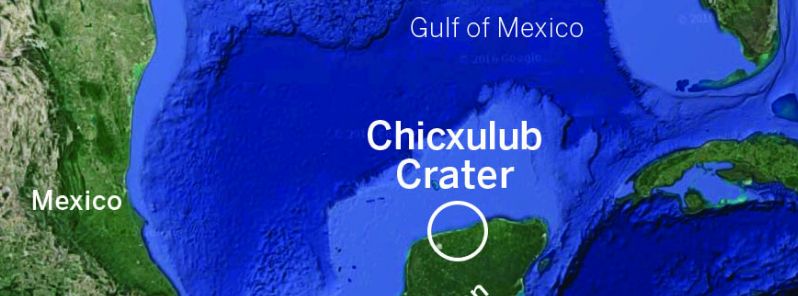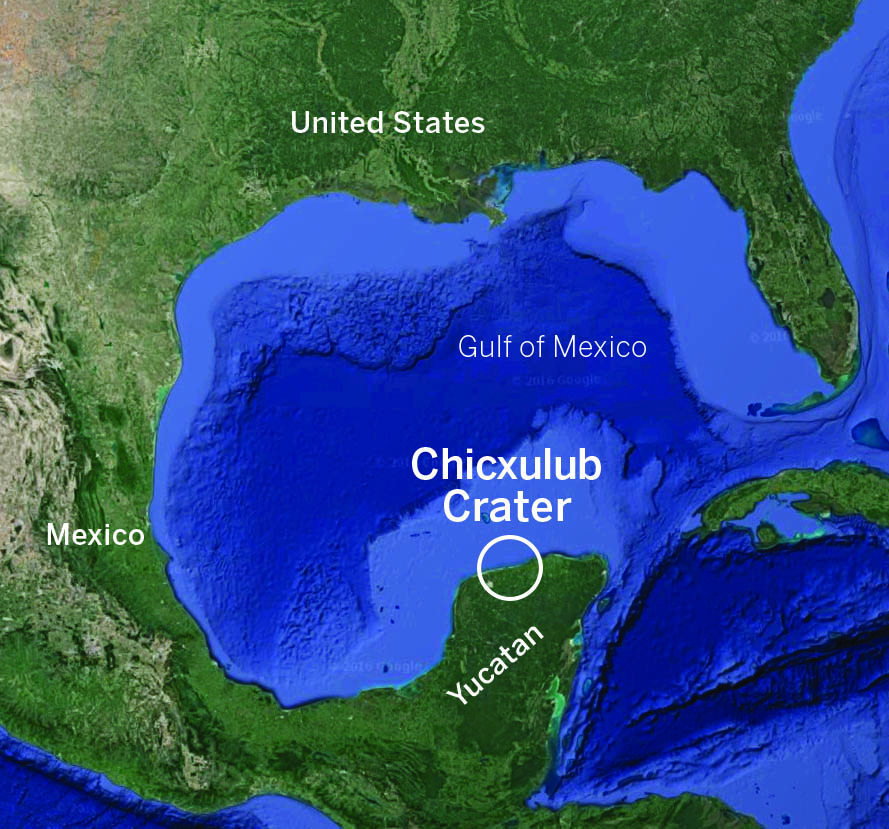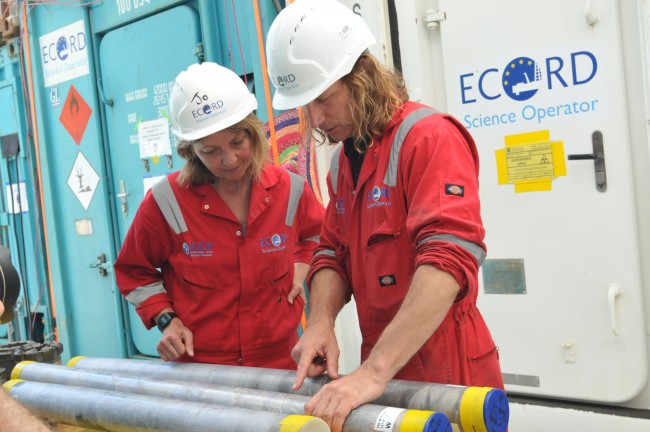Earth’s surface acts like liquid after deadly asteroid impact

A new research of a large 66 million years old asteroid crater, likely responsible for wiping out the dinosaurs and majority of other life on Earth, revealed how such impacts can cause a surface to behave like liquids, thus possibly providing habitats for emerging new life.
The scientific team, lead by the researchers from the University of Texas, Austin and Imperial College London, has utilized the data collected during the April/May expedition that drilled into the peak ring of the Chicxulub crater, located in the Gulf of Mexico.
According to Sean Gulick, a research professor at the University of Texas Institute for Geophysics, the study has definitely ended other possible theories explaining how such intense impacts are responsible for deforming the surface by melting the rocks around the impact area.

A location of the Chicxulub crater. Image credit: Google Maps/UT Jackson School of Geosciences
Such forceful impacts are common on other planets and the Earth's moon and the research, highly important for understanding the process, revealed that the mountain or hills around the impact area consist of deep crust rocks.
“It is the same exact kind of feature that we see on all large impacts on rocky planets, whether it be on Venus, on Mercury or on the moon. They’re a ubiquitous feature. Yet, prior to this drilling, we did not know how they were formed or what they were made of. What you’re actually seeing is a window into the crust kilometers down,” explained Gulick.

Video credit: The University of Texas Jackson School of Geosciences
The peak ring, from which the expedition team drilled the samples, is now covered by water and the limestone of the present day surface. According to the research result, the massive asteroid which probably hit the region with a force of 100 million atomic bombs, had created a huge, 30.6 km (19 miles) deep and 193.1 km (120 miles) wide, hole in the area.
The collected cores contained a pink granite material, usually found in deeper places of the planet.
“It was obvious and exhilarating. That was the big find because it says the peak ring didn’t come from something shallow. It came from something deep because it is made up of these buried crustal rocks that are now near the surface,” added Gulick.
The asteroid which hit the region was approximately 16 km (10 miles) wide, and it pushed the rocks from up to 9.6 km (6 miles) below the surface to form the peak ring region. The calculations suggest the below-surface rocks have been pushed for about 32.2 km (20 miles) in only a few minutes. They were pushed out of the impact region at first and have then bounced above the planet's surface, only to collapse in a ring of peaks centered at the asteroid crater.
The impact has lowered the density and increased the porosity values of the rocks, as the collected granites contained about 10% pore space, an amount far greater than the expected 1 to 2%. The research can also explain why the moon's crust shows unusually high porosity values, as it was frequently hit by the similar forceful asteroids.


The cores were collected by a drill rig aboard the Liftboat Myrtle. Image credit: UT Jackson School of Geosciences
It is important to stress that the rocks remained solid in the process, although they were behaving like liquids. It appears the material was shocked or damaged in such a measure that it lost the cohesion properties for the time being, and started acting like a slow-moving liquid. However, how the physical process actually happened is a question that still needs answering.
Rocks of such high porosity can become a habitat for chemosynthetic forms of life, and can be rich in nutrients within the pores from the circulating water, heated when the impact took place. Our planet was frequently hit by asteroids during its early life stage, and it is highly probable that these impacts have produced surfaces of similar physical properties.


Sean Gulick and Joanna Morgan examining a core sample from the Chicxulub crater. Image credit: UT Jackson School of Geosciences
“It is hard to believe that the same forces that destroyed the dinosaurs may have also played a part much earlier on in Earth’s history by providing the first refuges for early life on the planet. We are hoping that further analyses of the core samples will provide more insights into how life can exist in these subterranean environments,” said Joanna Morgan, a professor at Imperial College London, a lead author of the study and the co-principal investigator of the expedition, Joanna Morgan.
Reference:
- "The formation of peak rings in large impact craters" – Joanna V. Morgan et al. – Science – November 18, 2016 – DOI: 10.1126/science.aah6561
Featured image: A location of the Chicxulub crater. Image credit: Google Maps/UT Jackson School of Geosciences

Commenting rules and guidelines
We value the thoughts and opinions of our readers and welcome healthy discussions on our website. In order to maintain a respectful and positive community, we ask that all commenters follow these rules.